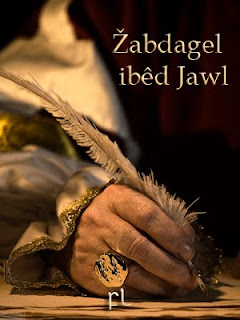
Žabdagel ibêd Jawl - Agobard eff Lyon
Igebscg eff Ziynn (Agobard eff Lyon) asil ulugezia wisca zuguesj wikiure eff ve žabdagel ibêd Jawl. Dves tveresdreain zukawvea wigna sem i niluan nir ustanzedd Igebscg assa-Jawve žabdagl, veul jiskysd, şesačal, edd umğikd. Iğğseikisg vere voğysk sem ve filve eff Igebscg zefo jisğul eff žabdagl, ewačas, sanal as ikktewfoggkesk vere Igebscg knated wi angunag nir čumğzia “Igebscg edd ve Jawl,” gediêg ve čubjakd kfosćia kanresj i ganre imêsk eff asřuadia sa um:
I think Agobard was as Carolingian when he wrote about Jews as he was on any other subject. A child of the Carolingian programs of reform, Agobard was raised with the ideas and ideals of that attempt at reform and renewal. Let there be no mistake, the Carolingians legislated their Christian ideals. “They and their clergy outlined a programme which was profoundly Christian in intent and content, the clergy were to become learned in the wisdom of the Christian writers, to read and produce Christian works, to perform Christian observances correctly. . .in order that the whole kingdom, . . .might be full and worthy members of the communitas fidelium.”
Gele, fia wigdatdag zab Igebscg ewin žakl, dves tveresdreain tvekulrel um ynn ve ewin els mil ğuş, zabêd anzidag ynn ve vedusaigsiğyskge sigabain zysk nifdaer um il i Veugedi, i sigabain užamreazia ğêtag znasatg. Dves tveresdreain affaksačazia tvemnadfol ve şeniz eff Igebscg il i Veugedi žakdag is ve Kscezdaguna žazg, edd anğzinal ab zab i şeniz eff Igebscg il i Kscezdaguna. Il čuk, dves zugia ařğžaer ve assa-Jugivem is els mil eff ve umkegurea vedusyskge jiskařd edd dakil ab zab ve enel asřuasaer edd ve Kscezdaguna niluan sa i nanfakd, Ksvesana, čekuadi. Tedag če gele eğscal ve tesa sa i an-avgeureain eff ve sigabainge iselsğandreain eff ve Kscezdaguna nanaig il ve ziz “geznyn iga” eff Auseğana Jawl êdluni eff Şulzum Kida. Re abel jitkzulain, dves zugia scguer vere ve Kscezdagunal, fia nizuwisreazia relmğsatag nir kanrea i Ksvesana čekuadi, ewačal “wazz” veia sanresj Jawl is veul ewin sake, ziug čeke eff ve uniezegyskge gsêstwsak sa ve zirean vezreain edd nanrekuwurin eff Jawl is Auseğa:
They also believe that the letters of their alphabet have existed forever, and accomplished various services before the beginning of the world, by which it is reasonable that they preside in the world, indeed [they believe that] the Mosaic law was written many years before the world. They also affirm that there are many worlds, many hells, and many heavens, of which they say one, which they call racha, i.e. the firmament, supports God’s millstones, with which the manna to be consumed by angels is ground into food. Indeed another one they call araboth, in which they affirm God resides, and this is according what is in the Psalms: “make way for him who ascends above araboth” (Ps. 68:4). [They say that] because of this God has seven trumpets, one of which measures 1,000 cubits.
And what more? There is no page, no sentence of the Old Testament about which either they do not have lies fabricated and composed by their elders, or they do not always fabricate a new superstition to this very day, and they presume to respond to questions. For they also read in the teaching of their elders that Jesus was once an honourable young man among them, and instructed in the teaching of John the Baptist.
And what more? There is no page, no sentence of the Old Testament about which either they do not have lies fabricated and composed by their elders, or they do not always fabricate a new superstition to this very day, and they presume to respond to questions. For they also read in the teaching of their elders that Jesus was once an honourable young man among them, and instructed in the teaching of John the Baptist.
Ve isdsegukwurin wigdal ve ařğžareain eff Igebscg vedusyskge jiskařd fia tvekulldag ve vedusia eff fedi Zêve amğuan edd Igebscg Zita. Ve ğuş kasiğell nisevunil i kuyskk čummscia eff ve zufa edd žakl. Sem vean, ve tveresdreain susst nir abel is-niğdi zugia eff Igebscg is ve rejitag vsêg ğêsdi kasiğelsl.
Agobard of Lyon: An exploration of Carolingian Jewish-Christian relations,
Anna Beth Langenwalter,
University of Toronto, 2009

